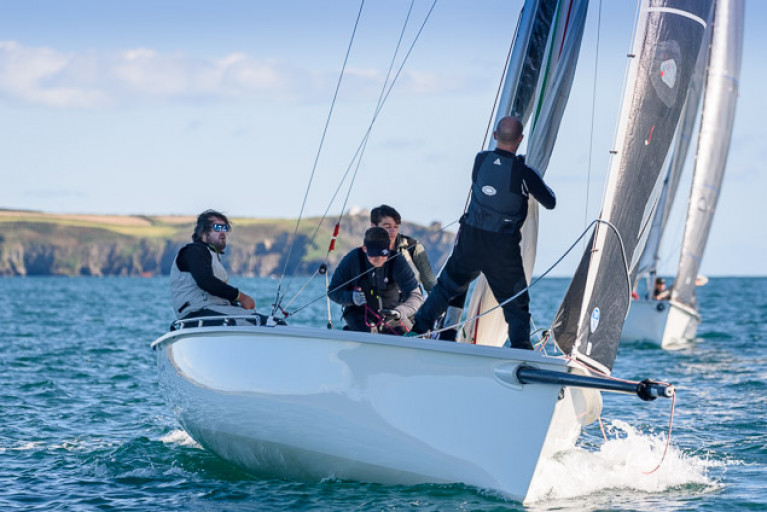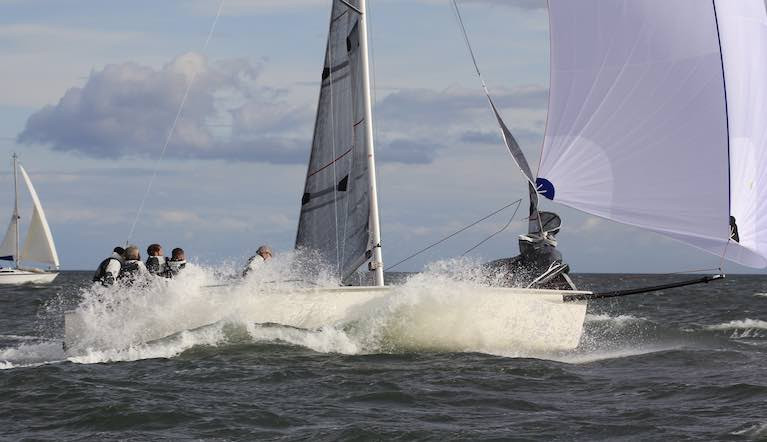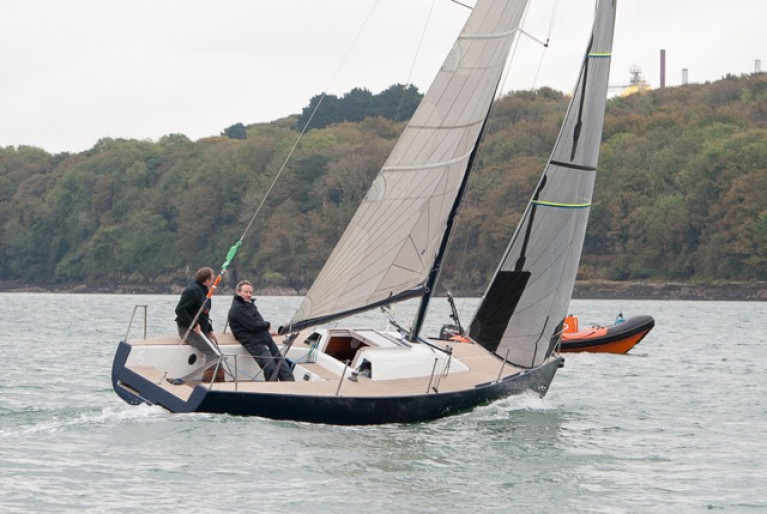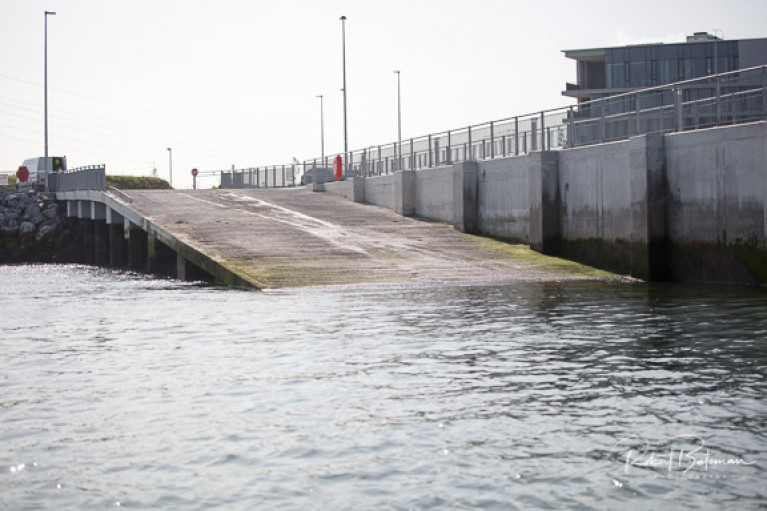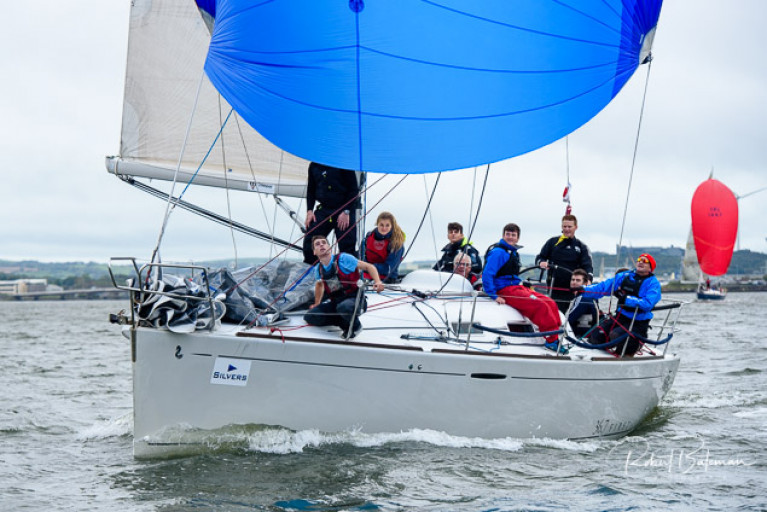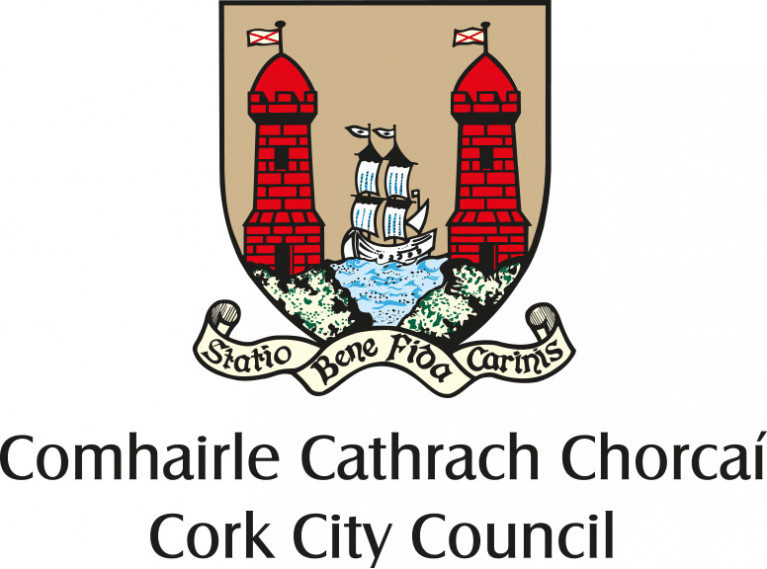Displaying items by tag: Cork Harbour
O'Leary's 'Dutch Gold' Crew from Baltimore Take the Lead at 1720 Munsters in Cork Harbour (Photo Gallery Here)
The leaderboard of the 1720 Munster Championships hosted jointly by Monkstown and Baltimore Sailing Clubs has a familiar look to it with Robert O'Leary's crew in Dutch Gold on top after four races sailed yesterday.
O'Leary, who has won both Baltimore Cup and Southern Championship honours this season, now leads by two points from his father Anthony and brother Nicholas in second place sailing Antix. Nine points back in third place is Mia Murphy's Aquatack.
 Anthony O'Leary's Antix is lying second at the 1720 Munsters in Cork Harbour Photo: Bob Bateman
Anthony O'Leary's Antix is lying second at the 1720 Munsters in Cork Harbour Photo: Bob Bateman
It's a smaller fleet in Cork Harbour after what was meant to be the national championships was forced to change both its race track and event title due to COVID-restrictions.
Dublin boats did not travel in line with restrictions and as a result, the fleet is ten boats as opposed to the 14 that raced for Southern honours, also in Cork Harbour, in August.
Racing continues today.
 Racing is taking place in Cork Harbour instead of the originally planned Cork Harbour Photo: Deirdre Horgan
Racing is taking place in Cork Harbour instead of the originally planned Cork Harbour Photo: Deirdre Horgan
 1720 Munsters 2020 at Monkstown and Baltimore Sailing Clubs (Sailed: 4, Discards: 0, To count: 4, Entries: 10)
1720 Munsters 2020 at Monkstown and Baltimore Sailing Clubs (Sailed: 4, Discards: 0, To count: 4, Entries: 10)
1720 Sportsboats Day One Photo Gallery by Bob Bateman Here!
Double Vision? Cork Harbour's Late Summer Brings Twin Versions of Classic Yachts
Those who have been rewarded for their careful adherence to social distancing and crew-pod rules by getting some sailing in the Indian summer which has been at its very best on Cork Harbour can be forgiven for wondering if, despite all their precautions, they've been afflicted by a mild bout of double vision.
For if you've been sailing down off Crosshaven, now and again you'll see this pretty little transom-sterned dark blue sloop with a nice crisp suit of new sails, out happily slicing her way with very little fuss across the blue water, her general appearance exuding quality construction, and her lone helmsman very deservedly the monarch of all he surveys.
 "Very deservedly the monarch of all he surveys". Photo: Bob Bateman
"Very deservedly the monarch of all he surveys". Photo: Bob Bateman
Yet if you're sailing further up the harbour off Monkstown on a somewhat similar day – for they seem to have had them in profusion – you'll have seen what looks to the casual observer to be the same boat, yet how does she seem to have two totally different home berths?
The up-harbour boat we featured here on August 14th, and she is, of course, Pat Murphy's Kinsale-built (in 1952) Colleen 23 class Pinkeen, beautifully brought up to condition by a combined effort by Pat and Jim Walsh of Walsh Boat Works in Nohoval.
 Happy man – Pat Murphy at the helm of Pinkeen off Cobh. Photo: Bob Bateman
Happy man – Pat Murphy at the helm of Pinkeen off Cobh. Photo: Bob Bateman
But the other boat – whose differences any dedicated aficionado can spot immediately – is a sort of nautical trompe l'oeil, as she's a complete re-working of a well-used but still sound fibreglass hull through the special genius of Bill Trafford of Alchemy Marine in Doneraile in North Cork order to create something else altogether.
Like many, Crosshaven sailor Philip Brownlow has the fondest memories of the three Alan Buchanan-designed Colleens which used to be based in Kinsale, where they'd been inaugurated by Nolly Stokes and John Thuillier. But while he wanted the spirit of the Colleens, he didn't want the demands of the continuous maintenance of an all-wooden boat, so he set Bill the challenge of re-purposing some other class's fibreglass hull to capture the Colleen essence, and Bill reckoned he could make the hull of a Kim Holman-designed Elizabethan 29 do the job, and this was how it was done. Nobody involved in the project makes claims that this is a Colleen 23. But they rightly believe that she captures the bright spirit of the Colleen 23, so maybe we should simply call her the Colleen 27.
 In distant Doneraile, the Colleen spirit is created with a re-purposed Elizabethan 29. Photo: Bill Trafford
In distant Doneraile, the Colleen spirit is created with a re-purposed Elizabethan 29. Photo: Bill Trafford
If you see Pat Murphy's Pinkeen and Philip Brownlow's Sunflower side-by-side, it's easy to spot the differences – not least because of the size gap – yet equally, the shared spirit shines through.
But if you happen to see them at two different times in different places in the harbour on the same day, confusion is understandable. As one occasional sailor put it: "The only way I know which is which is because one helmsman wears a Jack Charlton cap, and the other doesn't."
1720 National Championships Downgraded to 'Munsters' this Weekend at Monkstown Bay Sailing Club
This weekend's 1720 National Championships are to be downgraded to a Munster Championships in the wake of the recent government announcements that appeal to Dubliners not to travel outside the county.
As Afloat reported previously, the Championships had already moved from its original venue at Baltimore in West Cork over COVID and now the event will no longer be a 'nationals'.
The event due to be held now at Monkstown Bay Sailing Club in Cork Harbour will be amended to a two-day format on Saturday 26th & Sun 27th September.
Robert O'Leary has taken victories in August's 1720 Baltimore Cup and more recently in this month's Southern Championships, so if he and his Baltimore Crew can pull off another win, it looks like they will be unique among Ireland's one-design classes by being crowned 'Southern' and 'Munster' champions in the same season!
There is a plan for the 1720 class to say in Cork Harbour after the weekend and continue to race at Royal Cork Yacht Club's AIB Autumn League, as Afloat reported earlier here.
Wild Honey - The 'Ideal Little Yacht' for Unstressed Solo Sailing
Approaching his 60th birthday, Cork Harbour sailor Peter Murray was looking for a boat he could easily sail single-handed when he came across the eight-metre sportsboat' Wild Honey' in County Wicklow
My first sight of Wild Honey was on her road-trailer in a little boatyard at the bottom of a leafy boreen in County Wicklow. Designed as an out-and-out sports-boat by her owner Simon Greenwood of Wicklow, she was for sale while he concentrated on other projects. Surveys were arranged and a deal was done, and I found I had become the new owner of an uncompromising 8-metre sportsboat constructed in strip-cedar and weighing less than a ton fully rigged.
 Wild Honey - an 8-metre sportsboat constructed in strip-cedar
Wild Honey - an 8-metre sportsboat constructed in strip-cedar
Having previously owned a series of small racing yachts, I had taken a break from sailing for several years after I became self-employed. Now, with my 60th birthday approaching, and with it the prospect of having a bit more time on my hands, I was looking for a small yacht for leisure sailing on those fine summer evenings when all sailors fret at being ashore. I didn’t wish to be dependent on crew and one of my foremost requirements was for a boat I could easily sail single-handed. Because she would be kept on the marina, the boat would need to have auxiliary-power - but it had to be an arrangement that didn’t involve wrestling with an outboard motor over the transom.
 Because Wild Honey was kept on the marina, the boat would need to have auxiliary-power
Because Wild Honey was kept on the marina, the boat would need to have auxiliary-power
I was originally attracted by the new-generation of small day-sailers that had just begun to appear in the Mediterranean and on the lakes of Central Europe. These little yachts, sleek and elegant, and influenced by Italian yacht-designers Luca Benta and Luca Bassani (of ‘Wally’ fame), were frequently described as small “gentleman’s (or gentlewoman’s) day-sailers”, designed for pure sailing pleasure. The only glitch, I soon found out, was that these small sailing Ferraris came with Ferrari-like prices - so the idea of a “project” began to form. My first plan was to pick up an old 1720 sportsboat and convert it to what I had in mind. Then I heard of a little yacht ashore on the East Coast which might prove an even better starting point.
And that’s how I found myself, one October day in 2012, in a boatyard at the bottom of that leafy boreen in County Wicklow.
After Simon delivered Wild Honey to Cork, the serious planning and sourcing of equipment and materials began, and work was immediately started on removing all the deck-equipment and carrying out the alterations to the coachroof and down below needed to accommodate the rerouting and concealment of the sail-controls.
I had decided that the deck was to be clean and kept clear of all the control lines, and that these would be carried beneath the coachroof along two new watertight channels before emerging just ahead of the two sheet winches. A single-sheet self-tacking system was devised for the jib with a below-deck ‘Facnor’ furler mated to a ‘Bartels’ aluminium head-foil. To accommodate the furler and furler-lines below deck it was necessary to fix the original retractable articulating bowsprit laterally and to reduce its length slightly. This entailed redesigning the bow area, changing the forward chainplate arrangement, and straightening the bow-profile. The re-profiled bow had the added aesthetic benefit of giving Wild Honey a more modern looking plumb-bow. The shorter bow-sprit would still retract, but would now be fitted with a furler and torque-line for ‘top-down’ furling an asymmetric spinnaker or code ’0’ foresail. Like all the sail controls, the furler lines would be led below deck and out of sight.
A teak-laid deck was always an integral part of the plan to give the boat a “Wally”-like appearance. However, the time involved in preparing and shaping teak strips led me to look at alternatives. Eventually, I discovered an imitation teak product made in Sweden by “Flexiteek” whose appearance and texture make it virtually indistinguishable from the real thing - even at close inspection. I selected the colour-option that had the silver-grey look teak gets after exposure to the elements. One of the most exacting jobs in the entire operation was making the templates to enable the Flexiteek agent to fabricate the traditional herring-bone patterned decking. For this job, I had the indispensable assistance of an artist friend who showed me how to cut and shape the cardboard templates that would go to the Flexiteek agent. The time spent on getting it right was well worth it because when the decking came back it fitted perfectly, and it was a relatively easy - if rather messy - job to fit. However, when laid and cured, it was possible, just like real teak, to clean off the excess caulking with a power-sander.
Once the coachroof and bow alterations had been completed, and all the holes and hollows faired, and before the teak-decking was laid, Wild Honey was sent to the paint-shop for a complete re-spray. The original light blue paint-job had faded badly and the boat needed smartening-up. I decided to paint the hull and spars a very dark navy-blue which I hoped would best complement the new teak decking.
When the boat returned from the paint-shop all shiny and elegant, we laid the decking using synthetic black caulking supplied by the agent. We then began the work in planning the sail-control systems and placing and securing the deck-fittings. We were concerned about the compressibility of the Flexiteek under load, so the decking had to be cut out directly underneath all the deck fittings, and hard pads fabricated to match the cut-outs before we secured the sheet-winches, pad-eyes, mainsheet track, and stanchions.
I had originally intended to construct a well in the aft-deck for the small outboard motor. However, early in the project, I decided on a more ambitious solution to the auxiliary power question and one more in keeping with the character of the project by installing electric inboard propulsion. Research on the web led me to the Lynch Motor Company in Devon who make a series of small and powerful electric ‘pancake’ motors and control-systems suitable for marine applications. Further enquiries established that the marine-equipment company, Silettes, could supply a suitable sail-drive leg and a mating-flange. The motor I fitted is rated at about 4 HP, driving a 35mm’ ‘Gori’ folding prop, all of which is more than adequate to drive a small light-displacement yacht. Two deep-cycle AGM batteries, arranged ‘in series’, supply the required 24 volts.

The motor is capable of driving the boat at up to 5 kts depending on sea-conditions and has an endurance at 2/3rds power of about an hour and a half. Endurance isn’t an issue anyhow because the motor is normally only needed to get on and off the marina. The engine, batteries, control-system, saildrive and prop, weigh under 90 kg - far less than a small diesel and its ancillaries. One advantage of an electric motor in addition to silent operation is that it is completely vibration-free, which means the sail-drive unit on which the engine sits can be bolted directly to the hull without the necessity of the elaborate vibration-damping system required with diesel propulsion.
Wild Honey has a flexible, ‘walk-on’ solar cell array on the coachroof between the hatch and the mast. This is perfectly adequate for charge-maintenance and to recharge the batteries after a brief use of the motor. But after any prolonged use, the built-in shore-charger is needed to restore the batteries to full charge.
The final job was to reprofile the very narrow keel and increase the chord by about 30% to make the boat more forgiving to steer in very light conditions without significantly affecting her all-around performance.
The work to convert a very extreme racing sports-boat into an elegant day-sailer was carried out during the spring and summer of 2014, and Wild Honey in her new incarnation was launched at Crosshaven Boatyard in September of the same year. She immediately proved to be a joy to sail, requiring only the gentlest of breeze to get her moving, yet she is equally well able to stand up to her full sail in a stiff breeze. Like a traditional yacht, she depends on her very high ballast-ratio for stability, rather than beam and bodies on the rail. Her narrow hull also gives her an easy motion in a sea, and the lightness of a racing-dinghy on the helm - even when well-heeled. She is also as pretty as anything, drawing admiring comment, and has become a bit of a conversation-piece on the marina.
 All sail-controls led close to the helmsperson’s hand
All sail-controls led close to the helmsperson’s hand
With all sail-controls led close to the helmsperson’s hand, a furling self-tacking-jib, fully-battened mainsail with boom-strut and lazy-guys to make sail hoisting and handling simple, and an electric motor for getting on and off the marina, Wild Honey has proved the ideal little yacht for unstressed single-handed sailing in any conditions a “gentleperson” might wish to be out on the water in. She has been the perfect excuse to escape a little early from the office on those balmy summer evenings. I admit I’ve even done the odd race!
 Wild Honey - Specifications
Wild Honey - Specifications
Port of Cork Company Appoints New Chief Executive, Eoin McGettigan
The Port of Cork Company has appointed Eoin McGettigan to the role of Chief Executive of the company. Eoin replaces Brendan Keating who retired recently after 18 years of service as CEO.
The Chairman of the Port of Cork Company, John Mullins stated that ‘Brendan Keating made an outstanding contribution to the Port as Chief Executive since 2002. Brendan has seen the Port’s Strategic Development Plan fully recognised: the acquisition of Belvelly Port Facility (formerly Marino Point), the Inner Harbour Development at Bantry Bay Port Company, the marked increase in cruise business and the commencement of construction of the €86 million Cork Container Terminal in Ringaskiddy which will future proof the port. I have no doubt that Eoin will now take these projects and the business forward to further enable our growing economy.’
Eoin has spent the last decade providing strategic advice to a wide variety of companies. He has thirty years’ experience as a Senior Executive in Retail, Wholesale and Property businesses. He has held senior board positions in Musgrave PLC as Chief Executive of Supervalu Centra, Director of Dunnes Stores and Director of Reox Holdings PLC. Eoin and his family have lived in Cork for over 30 years.
John Mullins said: ‘Eoin brings with him a wealth of Senior Executive experience, excellent leadership skills and an integral knowledge of modern supply chains and logistics. He joins the Port at a strategic and exciting time for the company and the Southern region. The board and all in the Port company wish him every success.’
He added “Eoin will steward the company from the River to the Sea through the commissioning of key infrastructure in the lower harbour whilst making available former assets for critical residential and commercial development. Eoin’s property experience will be instrumental in ensuring that Tivoli will be one of the most exciting projects in the future for the company and for the City of Cork.’
Eoin McGettigan takes up the position as Chief Executive on 1st October 2020 for a term of five years.
Cork Harbour's Impressive Slipway & Marine Facilties at Paddy's Point in Ringaskiddy
As Afloat reported in July, the new public recreation area at Paddy's Point in Cork Harbour now has a new floating pontoon added to the existing marine leisure facilities at Ringaskiddy.
As it turns out, the new facilities were about to be put to championship use in August to handle a fleet at the Laser National Championships until the event had to be cancelled by Royal Cork Yacht Club due to COVID concerns.
The pier and slipway, that opened in May 2019 is located adjacent to the Beaufort Building in Ringaskiddy and is managed and maintained by the Port of Cork.
The substantial new facilities replace the existing Ringaskiddy slipway and pier and were completed as part of the Cork container terminal development.
 This new marine leisure facility is free for the public to use and includes a pontoon to launch leisure craft Photo: Bob Bateman
This new marine leisure facility is free for the public to use and includes a pontoon to launch leisure craft Photo: Bob Bateman
These latest photos of Paddy's Point further illustrate what a fine structure is now in situ and what a welcome addition it is to Cork Harbour's marine infrastructure.
Dorgan's First 36.7 is the Boat to Watch in the 2020 Cobh to Blackrock Race
Cove Sailing Club's 2020 Cobh to Blackrock Race will start earlier than normal this Saturday due to Cork Harbour tide times. A first gun at 1130 will see two separate starts for a combined fleet of 36 sailing cruisers (numbers restricted due to COVID) race on the flood off Cobh up to Blackrock Castle.
There is little doubting Kieran Dorgan's mastery of this race with wins for his yacht, the First 36.7 Altair, in both 2016 and 2018. It means he is the helmsman to watch even though this year there will be some interesting challenges to the Cobh Commodore. Form boat Denis and Annamarie Murphy's Nieulargo, a Grand Soleil 40, is also entered in Class One IRC Spinnaker division. The Murphy's have been big offshore this season winning both SCORA's Fastnet 450 and Kinsale's Fastnet Race but navigating the back eddies off Monkstown may yet be a different matter.
 Nieulargo (Grand Soleil 40) IRL2129, Denis & Annamarie Murphy
Nieulargo (Grand Soleil 40) IRL2129, Denis & Annamarie Murphy
Both Kieran Collins, Olson 30, Coracle and Ronan Downing's Half Tonner, Miss Whiplash are also entered in this crack nine boat division.
 Coracle (Olson 30) 1883 Kieran Collins
Coracle (Olson 30) 1883 Kieran Collins
 Miss Whiplash (Half Tonner) GBR5435R Ronan Downing
Miss Whiplash (Half Tonner) GBR5435R Ronan Downing
Two separate starts are planned for the 2020 race with IRC spinnaker divisions going first.
Although the race is sailed on a flood tide boats still go aground if they stray too far from the channel, so local knowledge for navigating this course is a prerequisite for success.
 Don't Dilly Dally (Etchells) 952 Michael McCann
Don't Dilly Dally (Etchells) 952 Michael McCann
IRC Two
IRC Two has just four boats competing and based on results from August club leagues, it is hard to ignore the threat of Michael McCann's well-sailed Etchells 22, Don't Dilly Dally. In a division that also contains the double Round Ireland Race winner Cavatina, A Granada 38, there will be no quarter given especially if Denis Byrne's Trapper 250, Cracker is sporting its new larger roached mainsail.
 Jap (Cork Harbour One Design) C4 Clayton Love
Jap (Cork Harbour One Design) C4 Clayton Love
White Sails
The biggest division in the 10-km race is the 23-boat white sail ECHO division where pride of place will surely go to the immaculately restored Jap racing on a generous handicap of .795. As Afloat previously reported Jap is now a special Royal Cork project boat and the 1897-built boat will be sailing past her shipyard of origin when she passes Carriagaloe going upriver this Saturday.
 Ré Eile (Moody 31) IRL731 Damian Ahern
Ré Eile (Moody 31) IRL731 Damian Ahern
 Prince of Tides (Grand Soleil 37B) IRL14544 Frank Caul
Prince of Tides (Grand Soleil 37B) IRL14544 Frank Caul
O'Leary Eyes Hat-Trick as 1720 Nationals Move to Cork Harbour for Joint Staging by Baltimore & Monkstown Bay Sailing Clubs
Robert O'Leary will be going for a hat-trick of 2020 1720 sportsboats victories later this month but not as originally scheduled, as the 1720 National Championships moves venue from Baltimore Sailing Club in West Cork to Monkstown Bay Sailing Club in Cork Harbour.
O'Leary won the 2020 Baltimore Cup a month ago and in the last weekend of August he won the Southern Championships at Royal Cork Yacht Club, so he and his Dutch Gold crew will quite rightly see the defence of the 1720 title as a crowning glory of the 2020 season.
However, he won't have it all his own way with a potent Ross McDonald crew of Howth biting at his heels. McDonald lost on countback at the Cup and was tied on points overnight after day one of the Southerns.
In a notice to competitors issued this month, Baltimore's Committee told competitors that 'after reviewing the current government guidelines and seeking guidance from the local businesses in Baltimore, we as a committee feel that we cannot provide the same level of racing and entertainment as experienced in the Baltimore Cup this year'.
 1720s return to Cork Harbour on September 25th Photo: Bob Bateman
1720s return to Cork Harbour on September 25th Photo: Bob Bateman
The West Cork club hopes to welcome the fleet back to Baltimore in 2021.
After discussions with Monkstown Bay Sailing Club, the 1720s have agreed to run the event in Cork Harbour on the same dates - 25th, 26th, 27th September 2020.
It will be a combined effort between the two clubs as both are of the opinion that the event should not be cancelled this year provided it can run it in line with the Covid-19 government guidelines.
It is the intention to launch, berth and recover boats in the Crosshaven River, with the primary race area being South East of the Harbour.
Cork City Council Motion Seeks Ban on 'Dangerous' Inflatable Craft
A motion has been put before Cork City Council seeking a ban on 'dangerous' inflatable craft.
It has been lodged by Cllr. Ted Tynan on behalf of the Workers Party: "In light of the recent rescue by fisherman Gus O'Donovan and crew member Mathew Byrne of two men on an inflatable craft in Crosshaven, I want to bring to the attention of the Council the dangers of such craft on our shores. This is just one of several water-related recent incidents that could have resulted in tragedy. I welcome the call by Chief executive of Water Safety Ireland, John Leech, for a ban on inflatable craft, in order to prevent a tragic outcome in our waters.
"Referring to 'supermarket inflatables', Hugh Mockler, Deputy, Launch Authority at Crosshaven RNLI, where Gus has been a crew member, described these craft as “downright dangerous”.
"I, therefore, call on Cork City Council to introduce the necessary by-laws to ban the use of inflatable craft on our shores and beaches".
Barry, Rimmington & Leonard Triumph at National 18 Southerns in Cork Harbour (Photo Gallery)
Alex Barry, Sandy Rimmington and Richard Leonard sailing Aquadisiacs were the overall winners of an 11-boat National 18 Southern Championships at Royal Cork Yacht Club last weekend.
The Royal Cork/Monkstown Bay trio won by a margin of three points over Barry's older brother Ewen steering FOMO crewed by Stanley Brown and Dion Barrett on 14 points. Two points back was third overall, Fifty Shades sailed by Laser ace Nick Walsh, Rob Brownlow and Eddie Rice.
The Aquadisiacs crew sailed a consistent seven-race series on Cork Harbour dipping only once out of the top three in a scoreline that included two race wins.
National 18 Southern Championships 2020 Results
 National 18 Southern Championships 2020 Results
National 18 Southern Championships 2020 Results



























